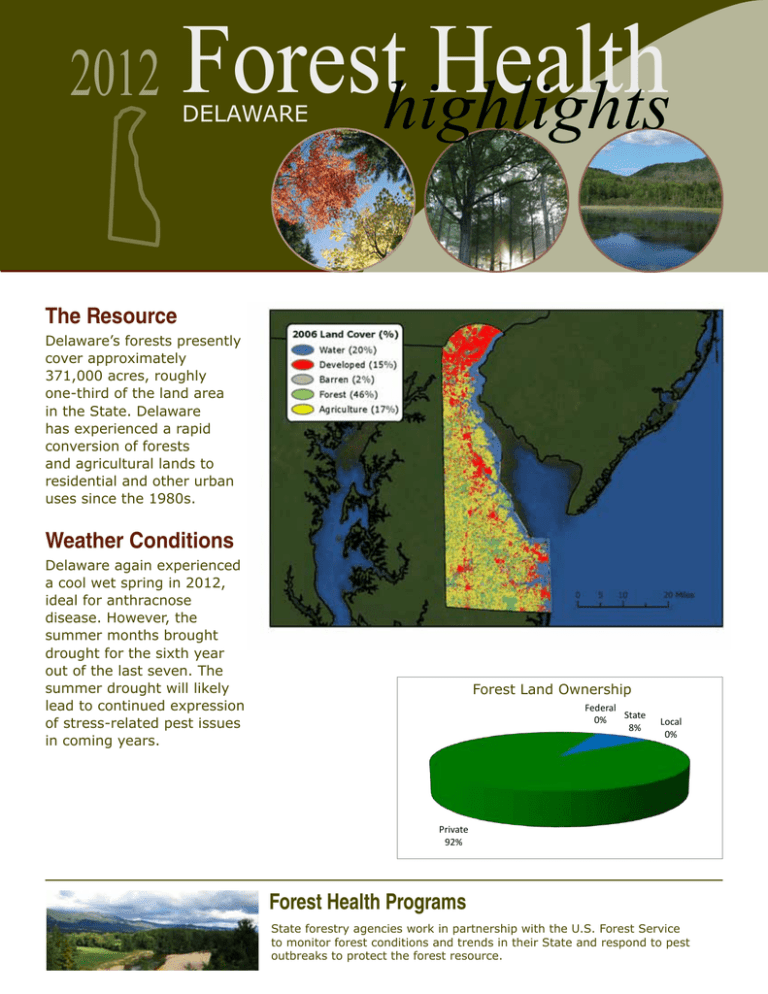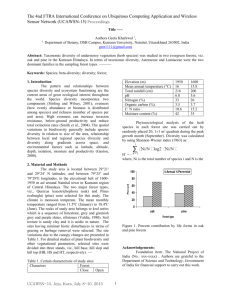Forest Health highlights 2012 DELAWARE
advertisement

2012 Foresthighlights Health DELAWARE The Resource Delaware’s forests presently cover approximately 371,000 acres, roughly one-third of the land area in the State. Delaware has experienced a rapid conversion of forests and agricultural lands to residential and other urban uses since the 1980s. Weather Conditions Delaware again experienced a cool wet spring in 2012, ideal for anthracnose disease. However, the summer months brought drought for the sixth year out of the last seven. The summer drought will likely lead to continued expression of stress-related pest issues in coming years. Forest Land Ownership Federal State 0% 8% Local 0% Private 92% Forest Health Programs Forest Land Ownership (PA) Federal 4% State State forestry agencies work in partnership with the U.S. Forest Service23% to monitor forest conditions and trends in their State and respond to pest outbreaks to protect the forest resource. West Virginia 7,546 Ohio Oak 2,677 3,517 Maple Aerial Surveys The southern portion of Delaware was flown in late June to detect gypsy moth, southern pine beetle, and other damaging agents. While no gypsy moth defoliation or southern pine beetle outbreaks were recorded, surveyors made digital maps of several dozen sites and followed up with ground inspections. Surveyors discovered about 20 acres of spring cankerworm defoliation of swamp chestnut oak in southern Sussex County. They also found approximately 300 acres with scattered mortality of oak and pine. Armillaria root rot; Ips, ambrosia, and turpentine beetles; and Hypoxylon canker were the most frequently observed causal agents. Most of these agents are considered secondary, with drought stress as the likely primary cause of this scattered mortality. Because drought stress is cumulative, and since Delaware has experienced drought frequently in recent years, we should expect some additional mortality in the future. 2 1,566 Hickory 2,432 989 Pine 862 755 495 Beech 445 Forest Species Type Oak Maple Pine Beech Hickory 0 50 100 million cubic feet 150 200 This map delineates aerial detection survey (ADS) results for Delaware in 2012 and 2011. 250 Late instar gypsy moth larvae at a post oak infestation site of just a few trees at a residence in Sussex County. Emerald Ash Borer (EAB) Spring cankerworm damage on swamp chestnut oak in Sussex County. Forest Pest Issues Gypsy Moth No significant defoliation due to gypsy moth (Lymantria dispar L.) was observed in 2012, although service foresters recorded a small number of isolated infestations in Sussex County. This marks the continuation of a downward trend in gypsy moth activity. The wet spring may have led to increased larval mortality caused by the parasitic fungus Entomophaga. Ash represents only about 1 percent of Delaware’s rural forests but is a significant component of the urban forest in some areas. In 2012, the Delaware Forest Service used three survey techniques to look for emerald ash borer (Agrilus planipennis Fairmaire). First, the Buprestid-hunting wasp Cerceris fumipennis was used in a biosurveillance program. Second, staff from the Delaware Forest Service helped the Plant Industries Section service 125 purple prism traps throughout the State. Finally, visual surveys were carried out at rest areas on Interstate 95 and Route 1. EAB was not detected. One of the purple prism traps in Sussex County used in the emerald ash borer survey. 3 Sirex Woodwasp 2012 SPB Count by Location 250 200 # of SPB Collected Sirex woodwasp (Sirex noctilio) presents a threat to loblolly pine, the mainstay of the forest products industry in southern Delaware. In 2012, 20 Lindgren traps baited with a Sirex blend were hung at seven sites. Sirex has yet to be detected in Delaware, although native Siricids were collected. Other Insects 150 100 50 0 Cypress Cape In 2012, service foresters reported Trap Pond Nanticoke Redden Swamp Henlopen light to moderate damage from Count 7 16 3 16 210 bagworm moth, eastern tent caterpillar, borers, ambrosia beetles, Figure 1.—2012 southern pine beetle collection data by location. Ips beetles, and fall webworm. Heavy infestations of tuliptree scale surveyed, it is unclear whether such high SPB were observed on yellow-poplar populations are typical of pitch pine stands throughout the State. The resulting sooty in this region, or whether this indicates a mold and yellow jackets led to numerous potential problem in the near future. calls from frustrated homeowners. Southern Pine Beetle (SPB) Southern pine beetle (Dendroctonus frontalis Zimmerman) and loblolly pine (Pinus taeda) are both native to Delaware. Since the mid-1990s, Delaware has participated in the Southwide SPB Pheromone study that surveys for SPB at four loblolly pine stands in Sussex County. In light of the 21,000 acres of SPB infestation in New Jersey in the previous 2 years that occurred primarily in pitch pine (Pinus rigida) stands, a fifth site was added to Delaware’s SPB survey for 2012. This site lies within Cape Henlopen State Park in a pitch pine stand. Somewhat surprisingly, SPB counts at the new pitch pine survey site were more than 10 times the average of the other four loblolly sites (figure 1). While aerial surveys and ground inspections with park managers did not reveal any damage from SPB, the situation will need to be monitored in coming years. Because this pitch pine stand had never been 4 Disease Concerns Hypoxylon Canker Widespread mortality due to Hypoxylon canker (Hypoxylon atropunctatum) was again seen throughout the State in 2012. This pathogen causes disease only in stressed trees. Several consecutive hot, dry summers predisposed trees to disease development. While many species were affected, oaks, especially southern red, white, and black, were most damaged. Service foresters again reported that this was the single most common damaging agent of oaks inspected during calendar year 2012. Other diseases Some damage and/or limited mortality were reported in 2012 from rust diseases, fire blight, anthracnose, and canker diseases. Moderate mortality was observed in oak and pine due to Armillaria root rot. Forest Health Monitoring Deer Exclosures Beech bark disease survey at White Clay Creek State Park; the disease has still not been detected in Delaware. Deer Exclosures – Delaware’s whitetailed deer herds benefit from near-ideal habitat and mild winters. As a result, deer populations have reached very high densities. Deer browsing has been documented as a factor affecting understory composition and ingrowth in hardwood forests. A study was initiated in 2005 to quantify the browse effect. Eighteen fenced exclosures have been installed in oak forests throughout Delaware. Measurements are taken at each exclosure and its accompanying control plot. Early results indicate significant differences between fenced and control plots, in as little as 3 years, in areas where deer density is greater than 50 per square mile. References Land Cover Map: U.S. Geological Survey. 2011. 2006 National land cover dataset. Sioux Falls, SD. Forest Land Ownership, Forest Species Type: U.S. Department of Agriculture, Forest Service. 2009. Forest resources of the United States, 2007. Gen. Tech. Rep. WO–78. Washington, DC. 336 p. Forest Health Protection U.S. Forest Service Northeastern Area State and Private Forestry 180 Canfield Street Morgantown, WV 26505 304–285–1545 http://www.na.fs.fed.us Delaware Forest Service 2320 South DuPont Highway Dover, DE 19901-5515 302–698–4500 http://dda.delaware.gov/forestry/ protec.shtml#forest_health_mon March 2013 The USDA is an equal opportunity provider and employer. 5




